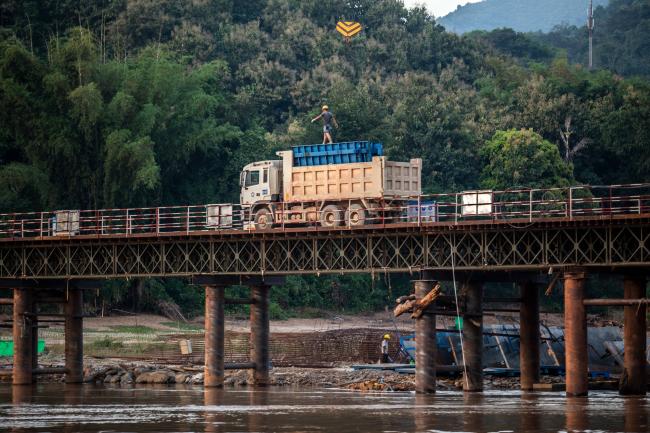(Bloomberg Opinion) -- If the definition of insanity is doing the same thing and expecting a different result, what are we to make of China’s plans to build a Silk Road railway through the heart of Asia?
After all, those who think steel tracks are the best way to shift goods from the Pacific to the Atlantic have been able to use the Trans-Siberian Railway since 1916. In practice, the efficiency, flexibility, volumes and logistical simplicity of maritime freight have won out again, and again, and again.
That’s even been the case in the past five years, when President Xi Jinping’s One Belt, One Road infrastructure initiative encouraged rail operators to splurge on subsidies and incentives like free advertising on Chinese state television to promote the overland route.
Thanks to China and Russia’s heavy endorsements, east-west container traffic over the Trans-Siberian Railway’s three main routes has surged to 278,000 twenty-foot-equivalent units in 2017 from 43,900 TEUs in 2014. Still, that’s less than half of the 480,000 TEU increase in traffic that shipping lines achieved over the same period, amid a once-in-a-generation crisis for the industry. Meanwhile, total maritime volumes on east-west routes hit 15.9 million TEUs last year, equivalent to almost 60 Trans-Siberian Railways.
There are fairly fundamental reasons for this. It takes about 15 grams of diesel to move one metric ton of freight a kilometer along U.S. railways, based on figures cited by logistics operator CSX Corp (NASDAQ:CSX). That sounds pretty good until you consider that a vessel capable of carrying the same ton a kilometer by sea needs only about 8 grams, and the fuel oil it consumes costs about a third less than rail diesel.
Combined with the almost infinite capacity of the seas compared with easily congested rail routes, ocean freight almost always wins out. Even in the short hop between the U.K. and France, shipping dominates, with 2.9 million freight units going by boat compared with 1.5 million through the Channel Tunnel in 2015. The maritime advantage only increases as distance rises:
That’s just the start of it. When Imperial Russia started building its railway network in the 19th century one of its biggest worries was invasion from a rail-borne foreign army, so former Soviet nations still use track wider than the standard gauge in China and Europe. Cargo trying to make it from Asia to Europe must either be transferred to different trains at each gauge break or have the bogies carrying their wheelsets physically swapped to the new size.
While solutions to these problems such as variable-gauge trains and new broad-gauge routes from Moscow to central Europe have been aired, they remain no more than proposals. Even then, shipments from Asia would still have to cross a minimum of three borders before making it to Poland, necessitating a further burden of customs checks.
How, then, to explain the rise in long-distance train traffic? Transit times, which used to be greater than those on sea routes, have improved over the past decade, opening up a narrow sweet spot for rail between low-cost, slow maritime transport and high-cost, rapid air freight.
In addition, companies such as HP Inc (NYSE:HPQ). that have established factories in China’s west must use a decent slice of domestic rail if they want to get their products to port quickly. Chongqing, where the firm has a laptop factory, is about 1,700 kilometers (1,056 miles) west of Shanghai, and the rail journey takes only three or four days compared with as many as 13 barging down the Yangtze. Doing the whole route to Europe overland isn’t such a bad option.
Still, one of the biggest factors is likely to be the opaque but significant subsidies available to anyone prepared for a spin on the tracks. Those available from parts of the Chinese government can range between $1,000 and $7,000 for each 40-foot shipping container, according to a March report by the Center for Strategic and International Studies. That’s an exorbitant level of support when you consider the cost of moving the same box from Shanghai to Rotterdam hardly ever breaks north of $2,000.
It’s a tribute to the romance of rail travel that whenever a train inaugurates a new path along the 12,000 kilometer-odd corridor between China and Europe it’s greeted not with reflections on the route’s obvious inadequacies but by dragon dancers, media scrums and breathless plaudits.
Even China’s banks seem smart enough to see what a busted project the government’s touted Eurasian land bridge is. Belt and Road spending is overwhelmingly concentrated in Pakistan, Malaysia and megaport projects like those that have sprung up in Sri Lanka and Myanmar. Investment in central Asian logistics has largely been confined to the Khorgos container hub on China’s border with Kazakhstan — a drop in the ocean in Belt-and-Road terms.
Rail’s disadvantages may get even worse in the future. At present, the shortest ocean route from China to Europe still clocks in at some 10,000 nautical miles, a 30-day journey. If global warming makes the Arctic Ocean north of Siberia a viable passage, that will drop by almost half, making ocean freight not just cheaper but as quick as train travel.
In China itself, rail traffic peaked in 2013 and has never quite recovered, despite an economy that’s grown by half since then. Global trade is unlikely to behave any differently.
